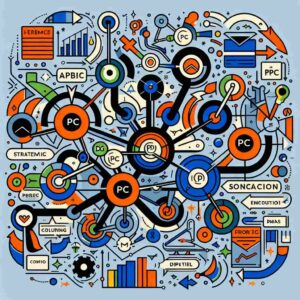If you’ve dabbled in digital marketing, you’ve likely come across a variety of acronyms that may seem like they’re written in a secret code. Fear not! This guide is here to help break down and explain the most important PPC acronyms and terms you need to know to excel in this space.
Let’s start with perhaps the most commonly used acronym in digital marketing: PPC, which stands for pay-per-click. As its name suggests, pay-per-click or PPC is an online advertising model where advertisers pay each time a user clicks on one of their online ads.
The world of PPC advertising can be a bit overwhelming, especially given the number of terms and acronyms associated with it. However, understanding these terms is crucial to understanding how PPC works and making it work for your business.
Why is Pay-Per-Click (PPC) So Important?
PPC is a cornerstone of effective online marketing. Anyone involved in online commerce should understand it in principle – whether you’re planning to use it directly or not. Here’s why:
- Reach: PPC has the potential to target a large audience on platforms such as Google or Facebook, offering incredible exposure for brands.
- Cost-effectiveness: Though it sounds pricey, savvy companies can make back their investment many times over by targeting ads to hit potential customers who are ready to buy.
- Data-driven: Everything about PPC is measurable – from the cost, profits, views, clicks, visits – making it easy to gauge success and modify strategies whenever necessary.
As we dive into the PPC acronyms and terms in the later sections, you will understand just how intrinsic these abbreviations are to pay-per-click marketing. These terms are much more than mere shorthand; they provide crucial knowledge that helps in navigating the complex terrains of digital advertising.

The Dictionary – Glossary of Relevant PPC Terms and Acronyms
You’ve made it through the introduction, now let’s dive into the heart of our guide: a comprehensive dictionary of crucial PPC terms and acronyms. To ensure you grasp every concept with ease, we’ll explain each term in alphabetical order.
API (Application Programming Interface)
An API allows different software to interact with each other. In the context of PPC, it can be useful for managing large or complex pay-per-click campaigns by pulling data directly from platforms like Google Ads into your own custom interface – saving you mountains of time on manual data entry.
AOV (Average Order Value)
The Average Order Value measures the average total of every order placed over a defined period of time. By tracking AOV in conjunction with PPC campaigns, businesses can better understand their return on ad spend (ROAS) and make strategic decisions about bidding and budget allocation.
BOPUS (Buy Online, Pick Up in Store)
This retail model has seen a surge in popularity due to its convenience and reduced shipping costs. For brick-and-mortar stores running PPC campaigns, promoting BOPUS options within ads can increase click-through rates and conversions.
Campaigns
In digital marketing language, a campaign refers to a set strategy for reaching a specific marketing goal. It’s a critical piece of your PPC puzzle as it helps organize your efforts around achievable targets.
CPA (Cost Per Acquisition)
This is the aggregate cost to acquire one paying customer on a campaign level. CPA encompasses not just the cost per click but also the conversion pathway. This metric helps advertisers understand the true cost of customer acquisition and allocation of marketing budget.
CPC (Cost Per Click)
CPC is exactly what it sounds like: the actual price you pay for each click in your PPC marketing campaigns. It’s a critical metric for understanding how much of your budget is spent on acquiring website clicks.
CTR (Click Through Rate)
The CTR tells you the percentage of people who clicked on your ad after seeing it. This key metric helps you gauge user response to your ads and landing pages, giving insights into their relevance and effectiveness.
Impressions
An impression represents each time an ad is shown on a search engine result page or other sites within the digital advertising network. If an ad is displayed 100 times, that’s 100 impressions – invaluable for gauging audience size and potential reach
This list starts to scratch the surface of PPC acronyms, but there are many more to come. Having a firm grasp of these terms will empower you to better understand campaign reports, make informed strategic decisions, and ultimately drive successful pay-per-click campaigns.

Unfolding the SEM and SEO Concepts
Now that we’ve covered some of the most essential PPC acronyms, it’s time to explore how PPC fits into the broader digital marketing landscape. Specifically, we’re going to delve into the interconnected topics of Search Engine Marketing (SEM) and Search Engine Optimization (SEO).
SEM, or Search Engine Marketing, is a comprehensive strategy for increasing visibility on search engines. It includes both paid tactics – primo among which is PPC – and free organic strategies.
On the flip side, SEO, or Search Engine Optimization, refers to the enhancement of website content and technical aspects to improve its organic ranking on search engine result pages (SERPs). Unlike PPC, SEO does not directly involve paying for ad space. Instead, it focuses on optimizing your site’s layout, loading speed, keywords usage, and backlink profile to naturally climb in search rankings.
While different in approach, SEM and SEO are two sides of the same coin and form an integral part of any comprehensive digital marketing strategy. They go hand-in-hand; while a well-managed PPC campaign under SEM can provide immediate visibility, a robust SEO strategy ensures sustained organic traffic over time.
The Interplay between SEM, SEO & PPC
If you visualize your company’s online presence as a building, think of SEO as building from the ground up: setting foundations with keyword research and site architecture before adding floors with new content and external backlinks.
In contrast, PPC advertising acts like an elevator installed in that building. It provides instant access to higher floors (top SERP spots), but at a cost. Without strong foundational work from SEO though, this elevator may hit snags.
You might be wondering why not use PPC alone to achieve quick results and ignore the slower process of SEO? The reason lies in consumer trust – organic listings often seem more authentic and reliable to users than paid ads. In addition, SEO has a relatively lower cost per acquisition long-term, making it an essential investment for businesses with tight advertising budgets.
While the world of SEM, SEO, and PPC may initially seem daunting, it’s much easier to navigate once you understand the interplay between them. Remember that these PPC acronyms and terms we’ve discussed are just part of the puzzle. To truly get ahead in digital marketing, you need a holistic understanding of all its parts, their functions, and how they fit together.
Deep Diving into Amazon PPC
If you are an online retailer or a brand selling its products on Amazon, understanding the concept and workings of Amazon PPC is crucial. It’s a unique arena where your products aren’t just competing against similar ones but also against millions of other items vying for visibility.
Amazon PPC is a pay-per-click advertising solution offered by Amazon itself. It works essentially in the same way as Google Ads (Google AdWords), Bing Ads, and other search marketing platforms – advertisers pay a fee when their ad gets clicked.
However, there are a few specific elements and terms related to Amazon PPC that retailers need to be familiar with:
Automatic Campaigns
In Automatic campaigns, Amazon does all the heavy lifting. The platform chooses relevant keywords for your ads based on the information available on your product page. These campaigns provide valuable insights into which keywords are converting best, and can form an excellent foundation for Manual campaigns.
Manual Campaigns
In comparison, Manual Campaigns require more hands-on management. They allow sellers to choose their own keywords and apply different match types (exact, phrase or broad) to optimize their campaigns better. While they demand more time and effort than automatic campaigns, manual campaigns give higher control over bid optimization and keyword targeting strategy.
Sponsored Products vs Sponsored Brands
Apart from automatic and manual complications, sellers have choices between ‘Sponsored Products’ and ‘Sponsored Brands’. While Sponsored Products target individual product listings, Sponsored Brands (previously known as Headline Search Ads) showcase your brand logo alongside 1-3 chosen products above the organic search results.
To thrive in such a competitive environment, sellers often depend on specialized PPC tools like ‘SellerApp’ that provides insights into the best performing keywords and your competitors’ strategies. Such tools help you to optimize your bids, track ad performance, discover new opportunities and ultimately amplify your sales.
With more than 197 million monthly visitors, Amazon is an online marketplace offering a massive potential for sellers who can navigate its complicated advertising landscape. By having a clear understanding of Amazon PPC acronyms, the platform’s unique terminology, and workings of this type of pay-per-click advertising, retailers can effectively reach its vast customer base.

Summing Up: The Ultimate PPC Acronyms and Advertising Terms Decoder
Congratulations! You’ve reached the end of our comprehensive guide to PPC acronyms and advertising terms. By now, you should have a solid grasp of the key concepts and terminology used in the world of pay-per-click advertising.
Understanding these acronyms is not only crucial for professionals working in digital marketing but also for business owners looking to leverage PPC as an effective marketing strategy. With this knowledge, you’ll be able to navigate the complex world of PPC with confidence and make informed decisions that can drive successful campaigns.
To recap, we covered essential terms like CPC (Cost Per Click), CTR (Click Through Rate), AOV (Average Order Value), CPA (Cost Per Acquisition), API (Application Programming Interface), and many more. Each term has its unique significance in understanding the performance, optimization, and success of your PPC campaigns.
Now that you’ve unlocked the code behind these acronyms, it’s crucial to apply this knowledge effectively. Here are some key takeaways:
1. Establishing Goals:
Determine your objectives before launching any PPC campaign – whether it’s driving website traffic, increasing brand visibility, or generating direct sales. Clearly defining your goals will help shape your overall strategy.
2. Choosing the Right Platforms:
Select the appropriate advertising platforms based on your target audience and industry. Google Ads is a popular choice due to its wide reach, but don’t overlook other platforms like Facebook Ads or Amazon PPC if they align better with your specific goals.
3. Effective Keyword Research:
Invest time in thorough keyword research to identify relevant search terms that match your business offerings. Use tools like Google Keyword Planner or SEMrush to discover high-volume keywords with reasonable competition.
4. Optimizing Ad Copy:
Create compelling ad copy that engages your audience and compels them to take action. Incorporate relevant keywords into your ad text while maintaining clarity and relevance.
5. Monitoring and Analysing Performance:
Regularly monitor the performance of your PPC campaigns using analytics tools provided by advertising platforms. Analyse metrics such as click-through rate, conversion rate, and return on investment to identify areas for improvement and make data-driven decisions.
6. Continuous Testing and Optimization:
Paid advertising is an ongoing process that requires continuous testing and optimization. Experiment with different ad formats, targeting options, and bidding strategies to find what works best for your business.
We hope this article has demystified the world of PPC acronyms and provided you with a solid foundation to excel in pay-per-click advertising. To further enhance your understanding, we recommend creating a system checklist or printable cheat-sheet containing all the important terms covered in this guide.
Remember, mastering these acronyms is just one part of becoming proficient in digital marketing. Stay up-to-date with industry trends and best practices to ensure long-term success with your advertising efforts.
The world of pay-per-click advertising is constantly evolving, so continue learning and exploring new strategies to stay ahead of the competition. Best of luck on your journey toward becoming a true PPC expert!

